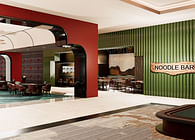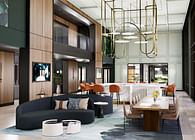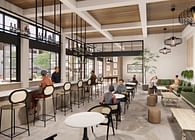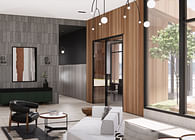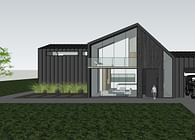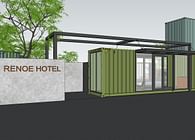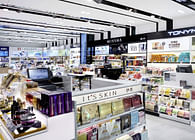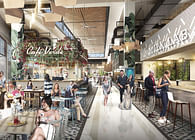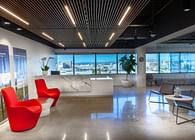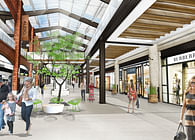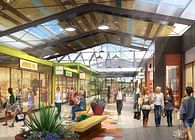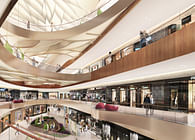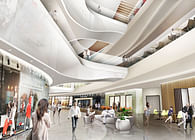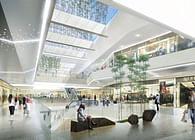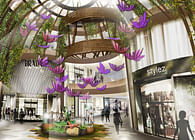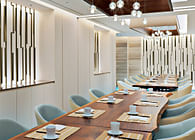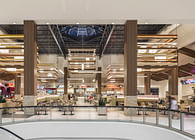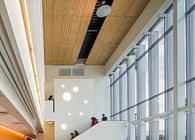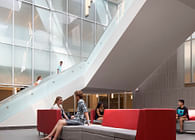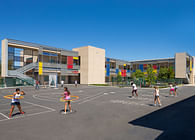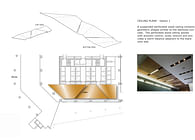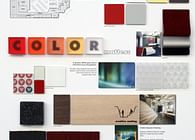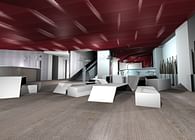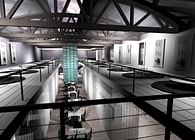
The concept of the space is influenced by several ways of giving life, weather it is from human fertility or a chicken hatching an egg, and even cloning, the process of making an identical copy of something.
The flow of the space is based on the assembly line, meaning an arrangement of tools and workers in which product is assembled by having each perform a specific, successive operation on an incomplete unit as it passes by in a series of stages organized in a direct line.
THESIS STATEMENT
What is the future of green design in the fashion industry?
According to the EPA, approximately 4 million tons of all waste sent to municipal landfills are comprised of textiles. The majority are originated from household sources and known as post-consumer waste. Ninety-nine percent of these used textiles are recy- clable.
What do we hope to see in the coming year?
It’s important to reflect on the environment and the state of the design industry and make some green design resolution. What important issues, movements, and ideas do we foresee being influential? Textile and clothing recycling can give used clothes and linens a second life and reduces the amount of waste going into landfills.
This proposed facility, called OVO, has the opportunity to lead by example on the issue of our time. It is OVO’s purpose to capture the essence of recycled fashion as a new form of art, put eco-garage hipster style artists on the map with their creative and intuitive sense for trashcan aristocracy, and lead the resale fashion industry.
In an effort to decrease the environmental impact of consumer waste and fast fashion, The industry will start to raise awareness on environmental issues. They will allow com- munity to take a second look at how we do business, from an ecological standpoint, and will encourage the community to rethink their basic day to day habits.
The location of OVO is in the Arts District of Los Angeles, California which is filled with older, industrial and former railroad buildings that started to become popular with the Los Angeles Art community. Back in the days, artists began buying and renting the buildings for their potential as art lofts. Therefore, it is very essential to reside OVO in this histori- cal environment. OVO occupies a historic railroad building which is now being used by SCI-ARC. The building is one of the longest buildings in California which fits perfectly for OVO and its concept. It is about 1091 feet long and 35 to 55 feet wide.
“Recycle, Reduce, and Reuse” is a statement OVO follows. The idea of giving a new life from one man’s trash and make it to a treasure for somebody else is great to feed to people. The concept of the space is influenced by several ways of giving life, whether it is from human fertility or a chicken hatching an egg, and even the con- troversial idea of cloning.
The inspirations of the architectures in the space are influenced from exploring the concept of fertilization. Mannequins that might have been dumped in garbage are reused as a tool to display garments. These futuristic mannequins are a very important subject in the space to create a “fantasy-meets-reality” environment. The interior space is very industrial to keep the history of the building. The materials and finishes are inspired from a warehouse or a factory. Used metal sheets and rails from an old car, aircraft, or even ships are recovered and reformed to the shapes of the architectures. All the structures are pre-fabricated and carefully placed inside to prevent the building from being damaged. Also by doing this, it will help to preserve this historical building. Since OVO cares about the environment, the glass windows throughout both sides of the building are kept to let the natural light flood the entire space to save energy during the production time. Also, it is very important to keep the building transparent to attract people to come in and participate in helping save the environment.
The flow of the space is based on how assembly line functions. OVO production is arranged from stage one, which is the beginning phase, through the final stage, which is stage five. The product is produced by having a specific and successive operation at each stage as it passes by in a series of stages organized in a direct line. OVO starts from collecting textiles from post-consumers, and then passes to the reconstruction stage. Here, the community can come in and use the studio to create unique pieces of clothing. An independent designer who uses the studio guarantees a fresh exposure to the community and maybe nation wide. In stage 3, Designer’s are given a space to dress-up their model mannequins for a fashion show and in stage 4 to showcase their work. The final stage is the second hand store. It combines a mixture of recycled vintage clothing, and re-constructed used clothing for sale to the public.
OVO hopes to send a positive message to the community and encourages them to be creative and not be afraid to express their thoughts and ideas. With great imaginations, comes great art and great design.
Status: School Project
Location: SCI ARC Building, Los Angeles, CA
